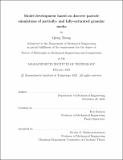Model development based on discrete particle simulations of partially- and fully-saturated granular media
Author(s)
Zhang, Qiong
DownloadThesis PDF (11.56Mb)
Advisor
Kamrin, Ken
Terms of use
Metadata
Show full item recordAbstract
Granular materials are ubiquitous in industrial and geophysical scenarios. At a high computational expense, the discrete element method (DEM) simulates granular materials with a high accuracy by tracking individual particles. At the other extreme, empirical formulas based on dimensional analysis and continuum models are convenient to be applied to large scale problems, but calibrations may be needed. In this thesis, DEM simulations are carried out as virtual experiments to study the particle-scale physics and then guide the formulation of empirical relations or continuum models for two applications.
Dynamic similarity, commonly applied in fluid systems, has recently been extended to locomotion problems in granular media. Our previous research was limited to locomotors in cohesionless, flat beds of grains under the assumption of a simple frictional fluid rheology. However, many natural circumstances involve beds that are sloped or composed of cohesive grains. Expanded scaling relations are derived and DEM simulations are performed as validation, with inclined beds and cohesive grains using rotating “wheels” of various shape families, varying size and loading conditions. The data show a good agreement between scaled tests, suggesting the usage of these scalings as a potential design tool for off-road vehicles and extra-planetary rovers, and as an analysis tool for bio-locomotion in soils.
In the bedload sediment transport process, the variability in the relation between sediment flux and driving factors is not well understood. At a given Shields number, the observed dimensionless transport rate can vary over a wide range in controlled systems. A two-way coupled fluid-grain numerical scheme has been validated against physical experiments of spherical sediment particles. It is used to explore the parameter space controlling sediment transport in simple systems. Examination of fluid-grain interactions shows fluid torque is non-negligible near the threshold. And the simulations guide the formulation of continuum models for the bedload transport and the creep flow. Furthermore, a numerical scheme has been developed to simulate the transport of natural shaped sediment particles. Conglomerated spheres, approximating the real shapes from CT scanning, are constructed in DEM and coupled with the fluid solver. Agreement with the corresponding flume experiments is observed.
Date issued
2023-02Department
Massachusetts Institute of Technology. Department of Mechanical EngineeringPublisher
Massachusetts Institute of Technology